Abstract
STUDY OBJECTIVE--Seasonality of birth was examined to determine whether this has changed over the last half century. DESIGN--Time-series analysis was carried out on retrospective data, both for the full 50 year period and for the five decades within that period. Although the primary objective was to investigate seasonality by fitting an appropriate model and examining changes over the period studied, non-seasonal trends were also examined. SETTING--Data by month were obtained from the Registrar General on all births in Scotland during the years 1938-87. SUBJECTS--There was a total of 4,325,000 births in the 50 years examined. MEASUREMENTS AND MAIN RESULTS--There are two peaks to the seasonality rhythm--one wide, in spring/early summer and one narrow, in October. Cosinor analysis, modified to allow for the second peak, was used to fit a sine curve model. Analysis of variance showed that this was adequate and established the significance of both peaks. The main peak of seasonal excess rose to a maximum in 1948-57, and thereafter declined by two thirds. While the position of the main peak moved forward two months over the 50 years, the October peak remained unchanged until the final decade, when it rose slightly; thus its relative importance increased steadily from 1948 onwards. CONCLUSIONS--The changing biological rhythm may be related to alterations in the climate and environment or to social differences.
Full text
PDF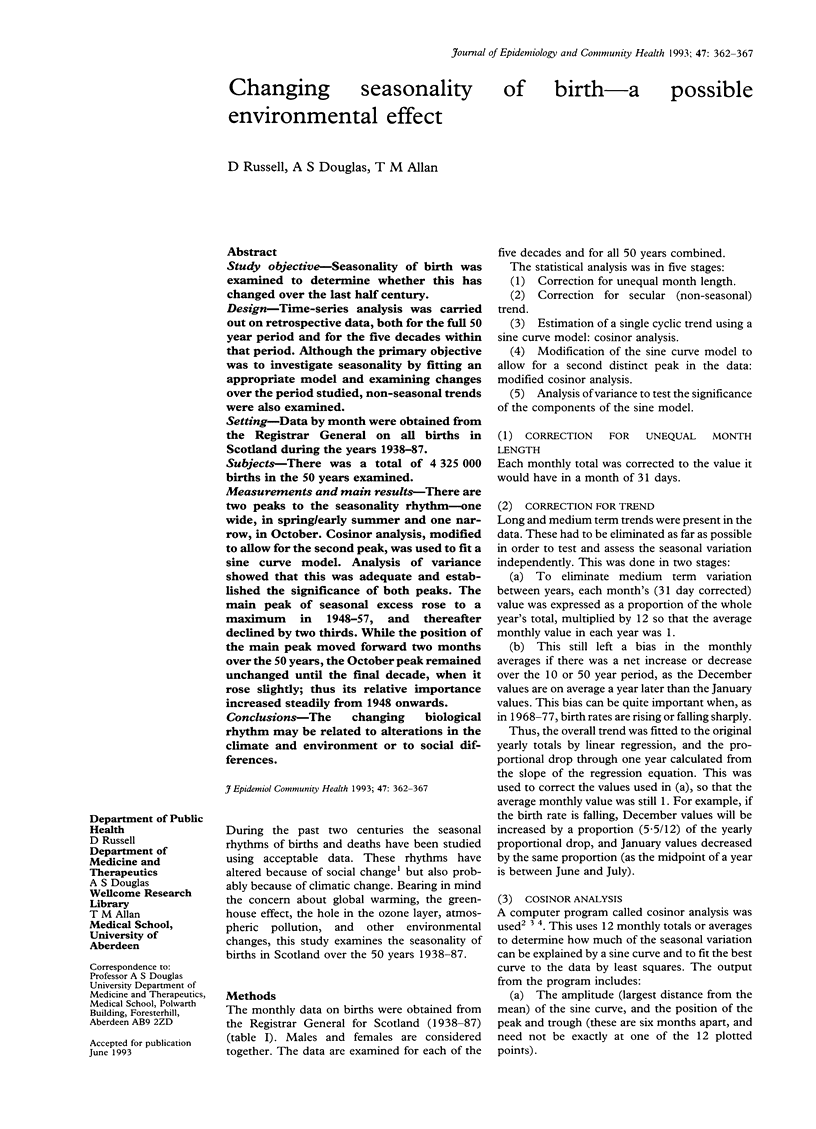
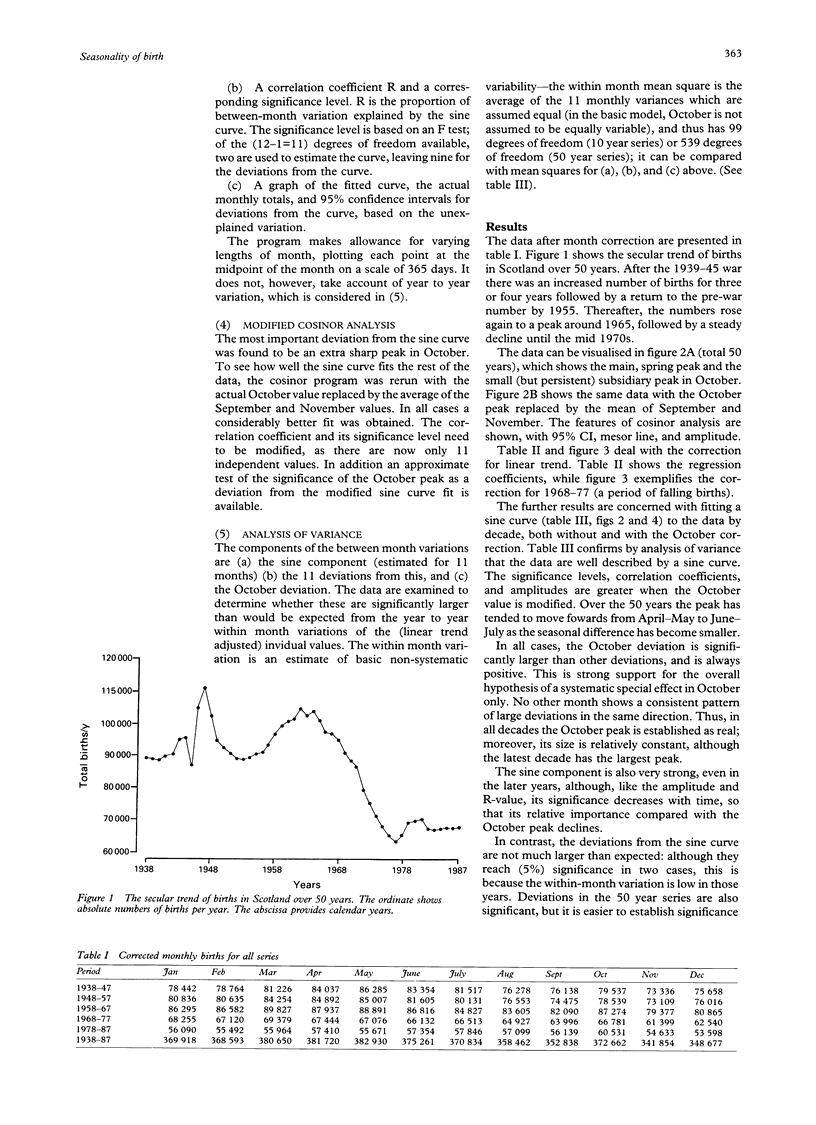
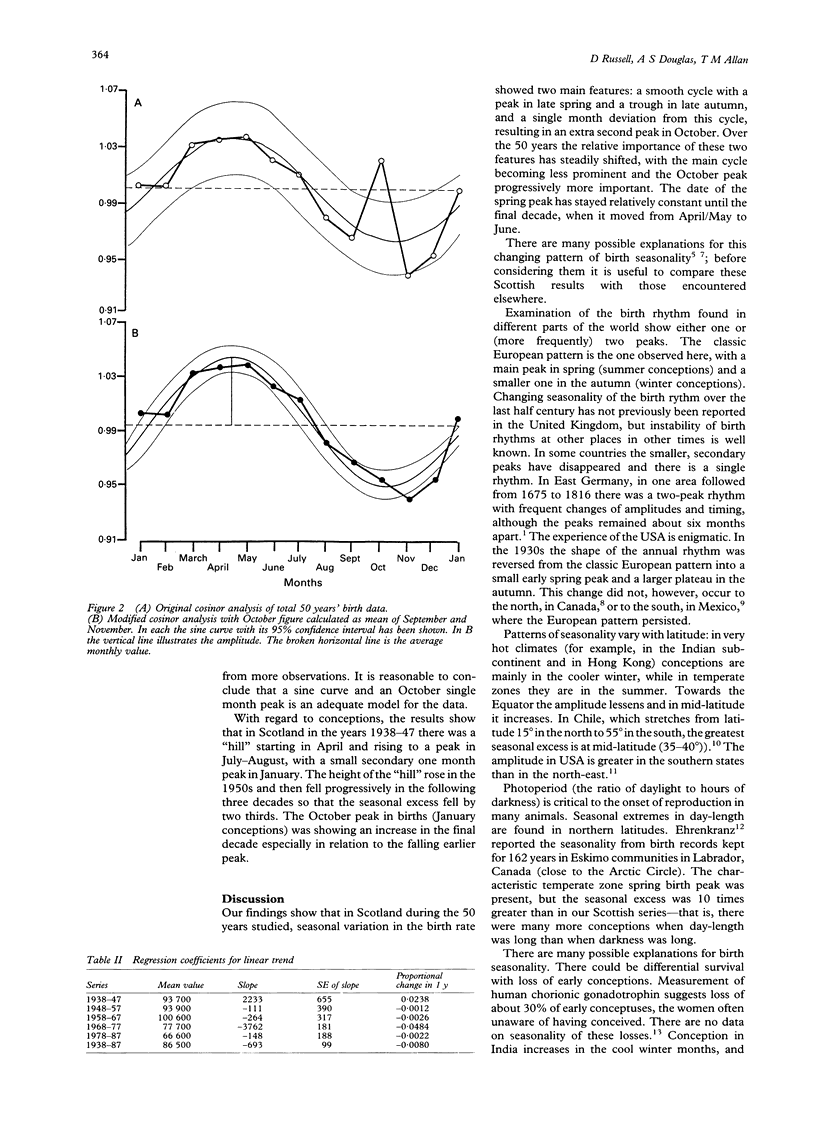
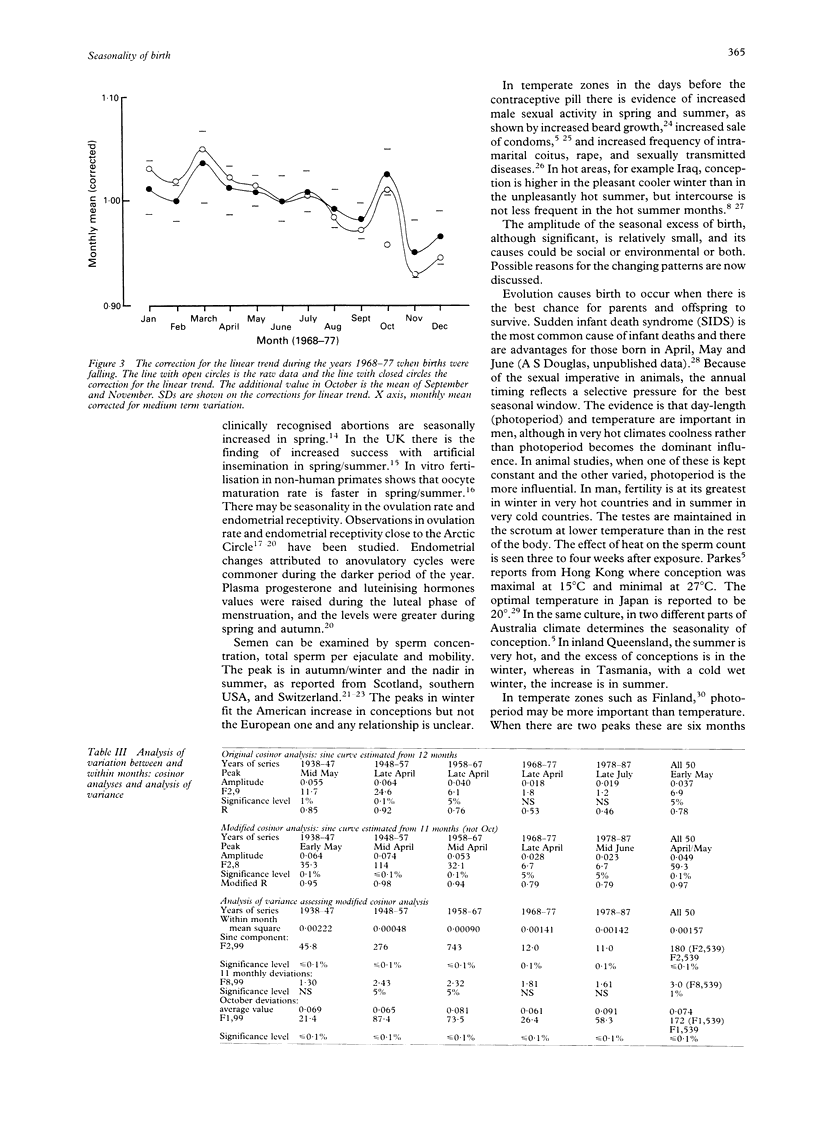
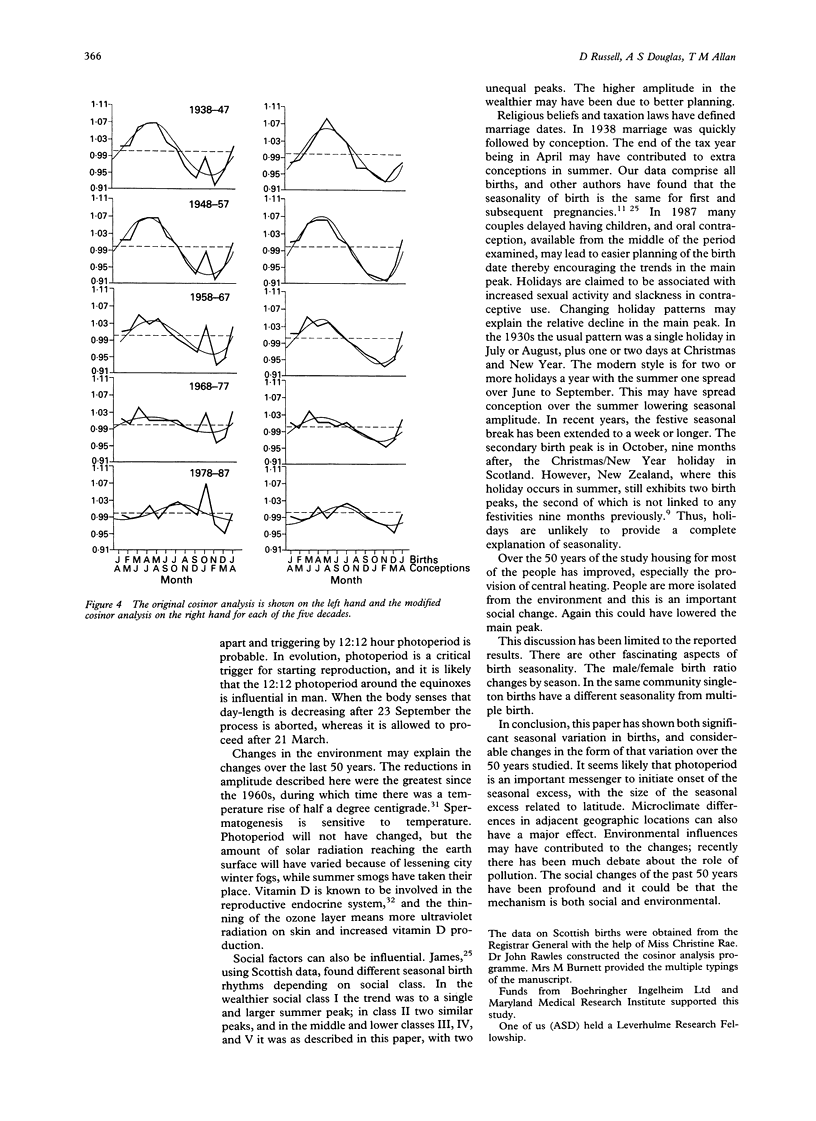
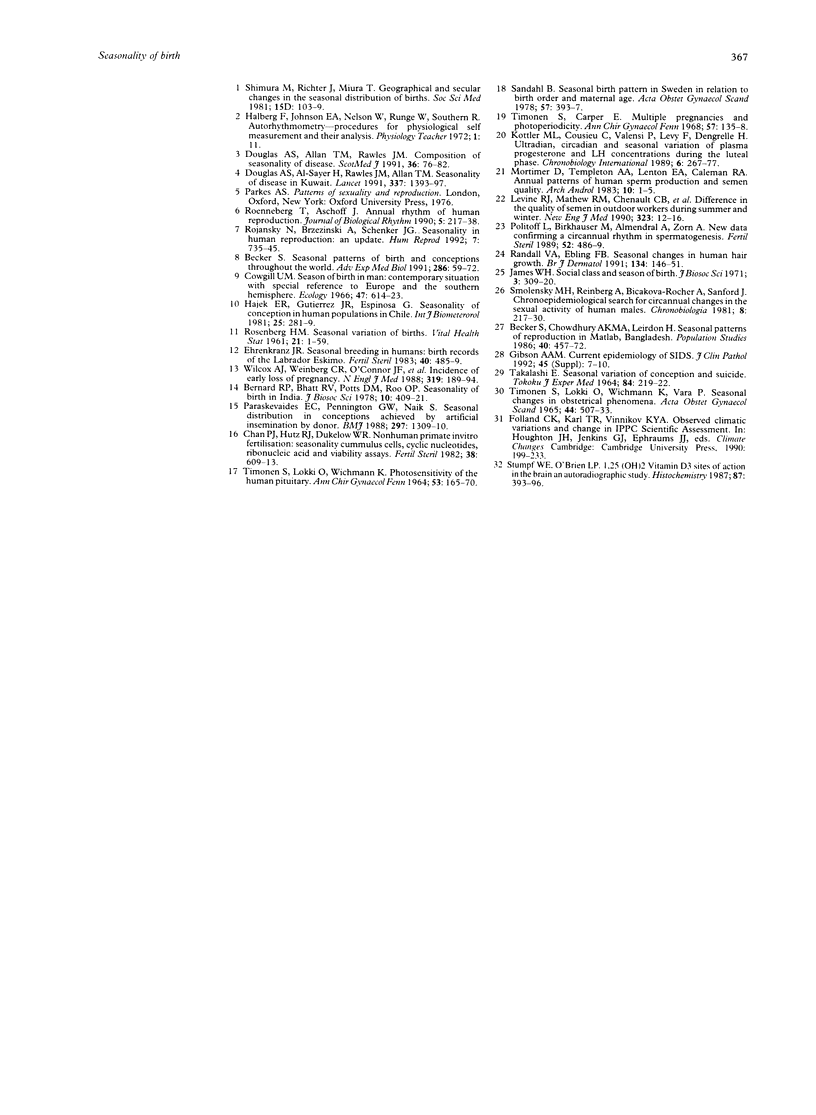
Selected References
These references are in PubMed. This may not be the complete list of references from this article.
- Becker S. Seasonal patterns of births and conception throughout the world. Adv Exp Med Biol. 1991;286:59–72. doi: 10.1007/978-1-4684-5913-5_6. [DOI] [PubMed] [Google Scholar]
- Bernard R. P., Bhatt R. V., Potts D. M., Rao A. P. Seasonality of birth in India. J Biosoc Sci. 1978 Oct;10(4):409–421. doi: 10.1017/s0021932000011901. [DOI] [PubMed] [Google Scholar]
- Chan P. J., Hutz R. J., Dukelow W. R. Nonhuman primate in vitro fertilization: seasonality, cumulus cells, cyclic nucleotides, ribonucleic acid, and viability assays. Fertil Steril. 1982 Nov;38(5):609–615. [PubMed] [Google Scholar]
- Douglas A. S., Allan T. M., Rawles J. M. Composition of seasonality of disease. Scott Med J. 1991 Jun;36(3):76–82. doi: 10.1177/003693309103600304. [DOI] [PubMed] [Google Scholar]
- Douglas A. S., al-Sayer H., Rawles J. M., Allan T. M. Seasonality of disease in Kuwait. Lancet. 1991 Jun 8;337(8754):1393–1397. doi: 10.1016/0140-6736(91)93069-l. [DOI] [PubMed] [Google Scholar]
- Ehrenkranz J. R. Seasonal breeding in humans: birth records of the Labrador Eskimo. Fertil Steril. 1983 Oct;40(4):485–489. doi: 10.1016/s0015-0282(16)47360-7. [DOI] [PubMed] [Google Scholar]
- Gibson A. A. Current epidemiology of SIDS. J Clin Pathol. 1992 Nov;45(11 Suppl):7–10. [PubMed] [Google Scholar]
- Hajek E. R., Gutiérrez J. R., Espinosa G. Seasonality of conception in human populations in Chile. Int J Biometeorol. 1981 Dec;25(4):281–291. doi: 10.1007/BF02198243. [DOI] [PubMed] [Google Scholar]
- James W. H. Social class and season of birth. J Biosoc Sci. 1971 Jul;3(3):309–320. doi: 10.1017/s0021932000008087. [DOI] [PubMed] [Google Scholar]
- Kottler M. L., Coussieu C., Valensi P., Levi F., Degrelle H. Ultradian, circadian and seasonal variations of plasma progesterone and LH concentrations during the luteal phase. Chronobiol Int. 1989;6(3):267–277. doi: 10.3109/07420528909056928. [DOI] [PubMed] [Google Scholar]
- Levine R. J., Mathew R. M., Chenault C. B., Brown M. H., Hurtt M. E., Bentley K. S., Mohr K. L., Working P. K. Differences in the quality of semen in outdoor workers during summer and winter. N Engl J Med. 1990 Jul 5;323(1):12–16. doi: 10.1056/NEJM199007053230103. [DOI] [PubMed] [Google Scholar]
- Mortimer D., Templeton A. A., Lenton E. A., Coleman R. A. Annual patterns of human sperm production and semen quality. Arch Androl. 1983 Mar;10(1):1–5. doi: 10.3109/01485018308990162. [DOI] [PubMed] [Google Scholar]
- Paraskevaides E. C., Pennington G. W., Naik S. Seasonal distribution in conceptions achieved by artificial insemination by donor. BMJ. 1988 Nov 19;297(6659):1309–1310. doi: 10.1136/bmj.297.6659.1309. [DOI] [PMC free article] [PubMed] [Google Scholar]
- Politoff L., Birkhauser M., Almendral A., Zorn A. New data confirming a circannual rhythm in spermatogenesis. Fertil Steril. 1989 Sep;52(3):486–489. doi: 10.1016/s0015-0282(16)60923-8. [DOI] [PubMed] [Google Scholar]
- Roenneberg T., Aschoff J. Annual rhythm of human reproduction: II. Environmental correlations. J Biol Rhythms. 1990 Fall;5(3):217–239. doi: 10.1177/074873049000500304. [DOI] [PubMed] [Google Scholar]
- Rojansky N., Brzezinski A., Schenker J. G. Seasonality in human reproduction: an update. Hum Reprod. 1992 Jul;7(6):735–745. doi: 10.1093/oxfordjournals.humrep.a137729. [DOI] [PubMed] [Google Scholar]
- Sandahl B. Seasonal birth pattern in Sweden in relation to birth order and maternal age. Acta Obstet Gynecol Scand. 1978;57(5):393–396. doi: 10.3109/00016347809156517. [DOI] [PubMed] [Google Scholar]
- Shimura M., Richter J., Miura T. Geographical and secular changes in the seasonal distribution of births. Soc Sci Med Med Geogr. 1981 Feb;15D(1):103–109. doi: 10.1016/0160-8002(81)90020-4. [DOI] [PubMed] [Google Scholar]
- Smolensky M. H., Reinberg A., Bicakova-Rocher A., Sanford J. Chronoepidemiological search for circannual changes in the sexual activity of human males. Chronobiologia. 1981 Jul-Sep;8(3):217–230. [PubMed] [Google Scholar]
- Stumpf W. E., O'Brien L. P. 1,25 (OH)2 vitamin D3 sites of action in the brain. An autoradiographic study. Histochemistry. 1987;87(5):393–406. doi: 10.1007/BF00496810. [DOI] [PubMed] [Google Scholar]
- TIMONEN S., FRANZAS B., WICHMANN K. PHOTOSENSIBILITY OF THE HUMAN PITUITARY. Ann Chir Gynaecol Fenn. 1964;53:165–172. [PubMed] [Google Scholar]
- Timonen S., Carpen E. Multiple pregnancies and photoperiodicity. Ann Chir Gynaecol Fenn. 1968;57(2):135–138. [PubMed] [Google Scholar]
- Wilcox A. J., Weinberg C. R., O'Connor J. F., Baird D. D., Schlatterer J. P., Canfield R. E., Armstrong E. G., Nisula B. C. Incidence of early loss of pregnancy. N Engl J Med. 1988 Jul 28;319(4):189–194. doi: 10.1056/NEJM198807283190401. [DOI] [PubMed] [Google Scholar]


